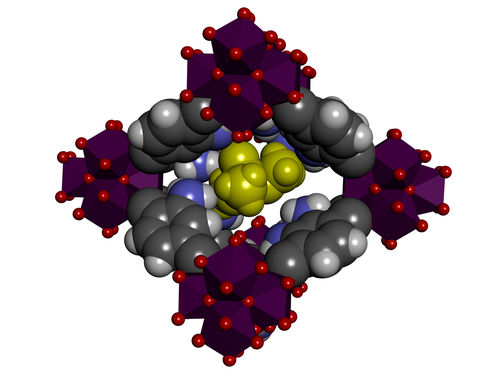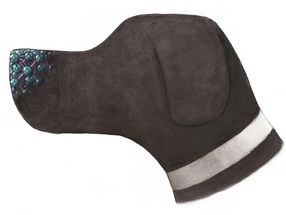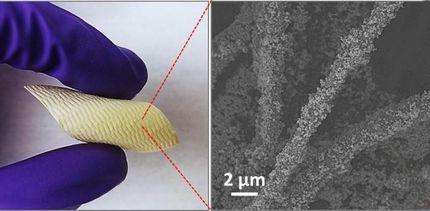Electronic nose smells pesticides and nerve gas
Detecting pesticides and nerve gas in very low concentrations made possible
Detecting pesticides and nerve gas in very low concentrations. An international team of researchers led by Ivo Stassen and Rob Ameloot from KU Leuven, Belgium, have made it possible.

The MOF used in this study consists of organic molecules (in grey and black) and metal ions (zirconium, in purple). Between these molecules are little holes that can absorb the phosphanates (in yellow).
© KU Leuven - Centre for Surface Chemistry & Catalysis

Detecting pesticides and nerve gas in very low concentrations. An international team of researchers led by Ivo Stassen and Rob Ameloot from KU Leuven, Belgium, have made it possible.
© KU Leuven - Joris Snaet


The best-known electronic nose is the breathalyser. As drivers breathe into the device, a chemical sensor measures the amount of alcohol in their breath. This chemical reaction is then converted into an electronic signal, allowing the police officer to read off the result. Alcohol is easy to detect, because the chemical reaction is specific and the concentration of the measured gas is fairly high. But many other gases are complex mixtures of molecules in very low concentrations. Building electronic noses to detect them is thus quite a challenge.
Researchers from KU Leuven have now built a very sensitive electronic nose with metal-organic frameworks (MOFs). "MOFs are like microscopic sponges," postdoctoral researcher Ivo Stassen explains. "They can absorb quite a lot of gas into their minuscule pores."
"We created a MOF that absorbs the phosphonates found in pesticides and nerve gases. This means you can use it to find traces of chemical weapons such as sarin or to identify the residue of pesticides on food. This MOF is the most sensitive gas sensor to date for these dangerous substances. Our measurements were conducted in cooperation with imec, the Leuven-based nanotechnology research centre. The concentrations we're dealing with are extremely low: parts per billion - a drop of water in an Olympic swimming pool - and parts per trillion."
The chemical sensor can easily be integrated into existing electronic devices, Professor Rob Ameloot adds. "You can apply the MOF as a thin film over the surface of, for instance, an electric circuit. Therefore, it's fairly easy to equip a smartphone with a gas sensor for pesticides and nerve gas."
"Further research will allow us to examine other applications as well," Professor Ameloot continues. "MOFs can measure very low concentrations, so we could use them to screen someone's breath for diseases such as lung cancer and MS in an early stage. Or we could use the signature scent of a product to find out whether food has gone bad or to distinguish imitation wine from the original. This technology, in other words, offers a wide range of perspectives."
Original publication
Stassen, I. and Bueken, B. and Reinsch, H. and Oudenhoven, J. F. M. and Wouters, D. and Hajek, J. and Van Speybroeck, V. and Stock, N. and Vereecken, P. M. and Van Schaijk, R. and De Vos, D. and Ameloot, R.; "Towards metal-organic framework based field effect chemical sensors: UiO-66-NH2 for nerve agent detection"; Chem. Sci.; 2016
Original publication
Stassen, I. and Bueken, B. and Reinsch, H. and Oudenhoven, J. F. M. and Wouters, D. and Hajek, J. and Van Speybroeck, V. and Stock, N. and Vereecken, P. M. and Van Schaijk, R. and De Vos, D. and Ameloot, R.; "Towards metal-organic framework based field effect chemical sensors: UiO-66-NH2 for nerve agent detection"; Chem. Sci.; 2016
Topics
Organizations
Other news from the department science

Get the chemical industry in your inbox
By submitting this form you agree that LUMITOS AG will send you the newsletter(s) selected above by email. Your data will not be passed on to third parties. Your data will be stored and processed in accordance with our data protection regulations. LUMITOS may contact you by email for the purpose of advertising or market and opinion surveys. You can revoke your consent at any time without giving reasons to LUMITOS AG, Ernst-Augustin-Str. 2, 12489 Berlin, Germany or by e-mail at revoke@lumitos.com with effect for the future. In addition, each email contains a link to unsubscribe from the corresponding newsletter.




























































